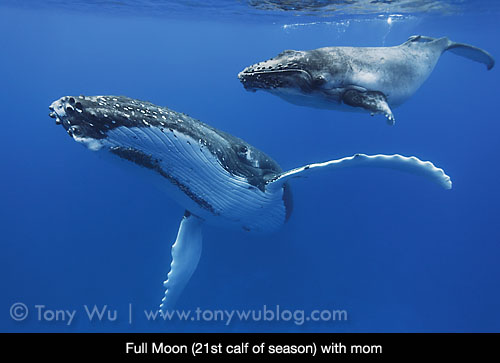 This past week was one of the most (if not the most) challenging and rewarding weeks I've had in Tonga.
This past week was one of the most (if not the most) challenging and rewarding weeks I've had in Tonga.
Challenging...because we had a lot of people from several countries here simultaneously: Officially...five from Japan, three from Singapore, two from France, two from the United States. Unofficially, we ended up taking fifteen Tongan students and their teacher out to swim with whales, and also helping a TV crew from Hong Kong.
Rewarding...because we pulled everything off without any major glitches, and because we were able to share the beauty and grace of the humpback whales with so many people from such diverse backgrounds...and influence so many lives in a positive manner.
Calfs, Calfs, Calfs
First and foremost, in the midst of all the activity, we managed to identify another nine calfs by the end of the week, bringing our total to 21 photo-verified mother/ calf pairs over four weeks (compared to 14 such pairs in the Vava'u area over a six-week period in 2008).
As I mentioned in my earlier posts from this season, I suspected early on that 2009 would be a great year for calfs. The abundance and intensity of heat runs over the past couple of years suggested a reasonable probability for a near-term increase in calf births. Emails, etc. from friends in Tonga that I received before I arrived suggested an early start to calf births. And finally, our initial pace of calf IDs suggested that...well, there were lots of babies around.
The calfs we ID-ed this week are:
Luna: Mom has a unique dorsal fin that's easy to spot
Vanilla: Named for the delicious vanilla gelato that a friend makes for us here
Sesame: Named for the mom and baby's resemblance to black sesame seeds
Bubbles: Named for the penchant of the attending escort to blow bubbles
Gelato: The other half of "vanilla gelato"
Dialga: A pokemon character (the influence of Takaji's kids)
Palkia: Ditto Dialga
Mama's Boy: Named for the tendency of the baby to stick next to mama, despite being large already
Full Moon: So named because we found the calf on the day of the full moon (actually just shy of one day after).
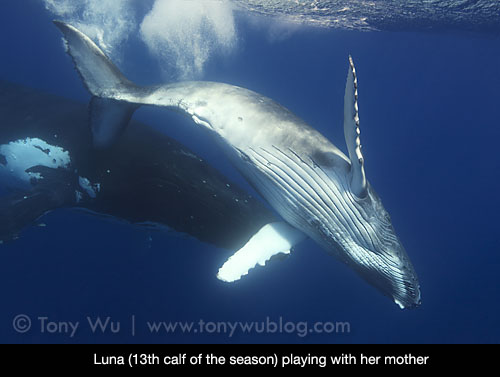
We also re-sighted Luna, Blackberry (from last week) and Dialga...adding to our list of repetitive sightings. The repetitive sightings are important, because they give us some insight into the movements of the moms and babies over time. Our working hypothesis based on last year's timeline is that the mother/ calf pairs don't stick around Vava'u for too long at any given time.
It seems as if they're here for a day/ a few days, then move on, sometimes re-visiting the area at a later point, sometimes never being seen again. Of course, it's entirely possible that they could re-visit without our noticing, but over time, hopefully we'll be able to glean some meaningful pattern from all the data points.
One thing I should mention is that it's not easy ID-ing the calfs. In most places (in fact, in all cases that I know of), humpback whale IDs are based on photographing the underside of their flukes (tails) when the whales dive.
This is better than doing nothing, but I see several inherent problems with this accepted methodology.
First, whales don't always show you the backside of their tails. In fact, most of the time they don't. And even if they do, you might miss the shot. This, by definition, significantly restricts opportunities for ID.
Second, there's a lot more to a humpback whale than its tail. By ignoring the rest of the body (on which there are often easily distinguishable, unique marks), you miss out on ID opportunities.
Finally, by restricting yourself to only taking photographs from a distance above water, you never actually see what's going on under the waterline, so you can't associate specific whales with specific behaviour...at least, not accurately. This, by definition, means you gain minimal (actually, quite often zero) insight into what whales are actually doing.
A parallel would be aliens studying human society by photographing only our asses from space while making a point of not observing our behaviour. For some people, this might be adequate. Most people (and whales), however, aren't just rear ends.
For all these reasons, we ID mom/ baby pairs by using underwater photos first and foremost, and then photographing from every angle possible. We of course look for unique fluke patterns, but we don't restrict ourselves. We also watch what the whales do underwater, and make notes (in writing and mentally) for future reference.
Our ID of Lilo earlier on this season, for instance, did rely on the fluke, but not the underside (which is what most other people use). We used the dorsal side, which is more readily visible but often ignored. Had we only concentrated on taking topside photos of the underside of the fluke, chances are high we would have missed this ID.
Some whales, like Luna's mother, have unique dorsal fins. Luna's mom's dorsal fin is almost non-existent, with a craggly stump in its place. This, plus four white rune-like marks on the stump, make it easy to ID Luna and her mom. In fact, when I happened upon the pair again two days after my initial ID, it took all over 0.000005 seconds to ID her. Again, had I obsessed about the underside of the fluke...
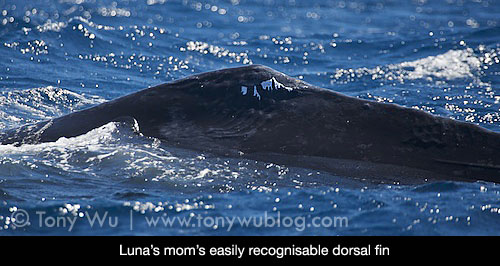
Other whales have no specific unique marking, but the sum total of the patterns on their bodies makes it easy to ID them...in which cases in-water full-body photos are invaluable.
Of course, taking good underwater photos of whales in a consistent manner isn't a simple process by any means. At this point, our hit rate is really high, because we know how to read the whales and understand how to behave around each one. Each whale is an individual, and their personalities can differ as much as the personalities of two different people. Accepting, understanding and respecting this is absolutely key.
People Power
The past week saw the most international group of people we've ever brought here.
Besides the logistical headache of making sure everyone's travel arrangements were in order, we had to contend with the challenges of operating in two languages (English and Japanese) and adapting to differing cultural norms. This is something that seems like it shouldn't be too difficult, but it can be stressful and exhausting. In fact...it was.
However (a BIG however), we had a great time, and we were fortunate, as we have been over the years, to have terrific people join us here. We enjoyed spending time with old friends; we made a lot of new friends; and hopefully, we made a lot of people really happy. The smiles, laughs, and squeals of delight (yes, you Serene), made the hard work worthwhile. All the people who had cameras took terrific photos, so they have a lot to show friends and memories to keep forever.
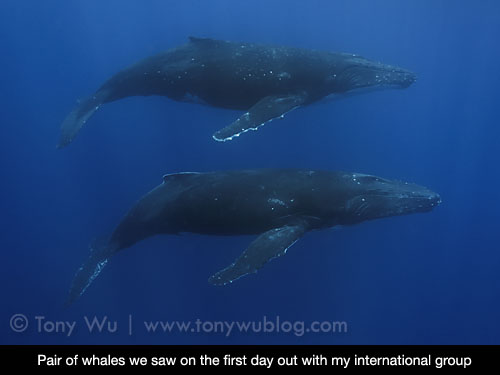
We also had unanticipated "guests" at the end of the week. On Saturday, I took out a group of fifteen students (+/-, I forgot to count exactly how many there were) and one of their teachers to swim with whales.
Most Tongan people in Vava'u have never seen a whale up close, much less been in the water with one. Quite often, it's a mystery to them why people would come from distant lands to get into cold, wet conditions just to see the tofua'a (whale in Tongan). Equally often, people here are scared to get into the ocean and/ or scared of being close to the whales.
We decided some time ago to contribute back to the local community, which has been really kind to us. One of the ways we're trying to do this is by teaching kids about the whales. Last year, we produced a short video that was shown to dozens of school kids, along with a short talk and Q&A about whales. We wanted to take some of the kids out last season, but the right circumstances never materialised.
On Saturday, after sending off some people at the airport, I rushed back into town and hopped on a friend's boat that we had chartered for the day to take the kids out. The weather was great (unusual this year), with low winds, bright sun, calm waters.
In short order, we found a chilled-out mother and calf (the one we named Full Moon) in clear visibility. At first, the kids were excited to be on the boat, but afraid to get into the water. It took a bit of convincing, but once the first of them joined me and came out of the water babbling incoherently with excitement, everyone wanted to get it...even the ones who initially maintained, "I can't swim!"
With such ideal circumstances, I was able to get all the kids in for a close-up look at the maternal bond and loving relationship between mother and baby humpback. The boat crew got in too, as well as other people on board.
All things considered, the day was a smashing success, and I have no doubt whatsoever that it's a day the kids will never forget. I'm pretty sure they understand now why people come from far and wide to peek under the waves. I'm really looking forward to doing this again at the next opportunity.
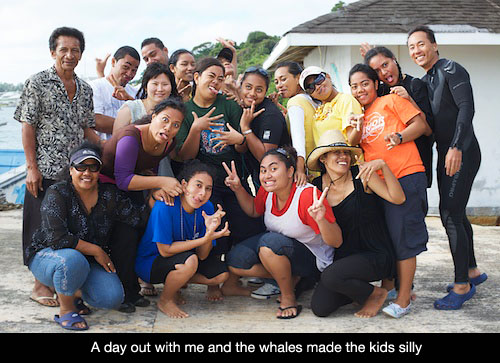
Finally, on Sunday (technically, not part of Week 4...but since I'm late writing this post, I might as well write about Sunday too), I had a TV crew from RTHK in Hong Kong with me. They had already spent a couple weeks here in Vava'u, so they had quite a bit of footage. They mainly wanted footage of me getting in/ out of the water, taking photos, swimming, etc.
So...we decided to roll the dice and look for cooperative whales in calm waters, figuring that we'd either find them the perfect conditions for filming, or we'd strike out. Fortune smiled upon us, and...bingo! We found a mom and baby whale in an ideal location, both of which gave them a beautiful performance both in-water and topside. (I named the calf Mei Mei, but she goes on next week's list).
Perhaps the best part of that day was getting the head guy, Jerry, into the water with the whales. Although he had been here for a while, the poor fellow had stayed topside the entire trip to film and give directions, letting everyone else experience the fun stuff. That's dedication.
So on his final day, Jerry finally made it into the water, and he emerged with same perma-grin that the high school kids and our international group of travellers had on their faces just days before.
Such is the positive power that in-water encounters with humpback whales can have.
Looking Ahead
The upcoming week will be our final one in Tonga this season.
On the one hand, I'm relieved, as it's been a long, tiring month so far and I really(!) need a break. On the other, I don't want to leave. I know I'll miss the whales right away and be wondering how many calfs I'm not seeing, how many heat runs I'm not enjoying, etc. And I know I'll miss all the great people of Vava'u, many of whom I count among my dearest friends.
After we leave, it'll take a bit of time, but we'll compile the calf data that we have, and I'll put together an organised summary, which again, as with last year, I'll post to the net and make available to anyone who wants to read it.
Finally, we'll commence planning for our 2010 schedule, so if you're interested in joining us, stay tuned...I'll post details soon.
